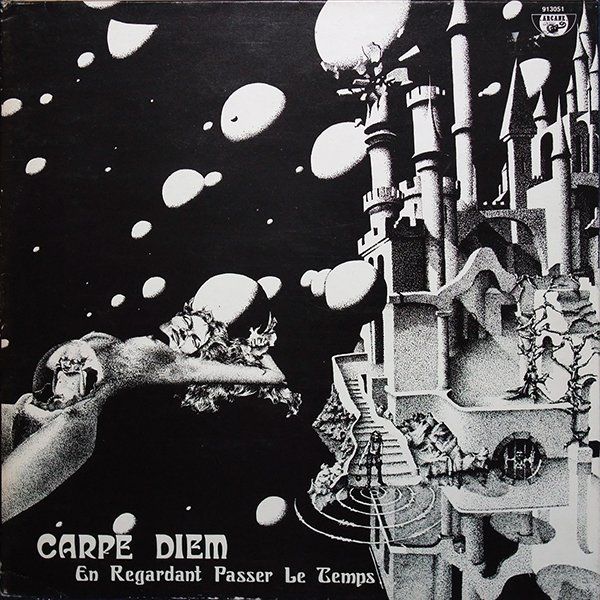
Exposé Online
What's old
Exposé print issues (1993-2011)
- 1 (October 1993)
- 2 (February 1994)
- 3 (May 1994)
- 4 (August 1994)
- 5 (October 1994)
- 6 (March 1995)
- 7 (July 1995)
- 8 (November 1995)
- 9 (March 1996)
- 10 (August 1996)
- 11 (February 1997)
- 12 (May 1997)
- 13 (October 1997)
- 14 (February 1998)
- 15 (July 1998)
- 16 (January 1999)
- 17 (April 1999)
- 18 (November 1999)
- 19 (May 2000)
- 20 (October 2000)
- 21 (March 2001)
- 22 (July 2001)
- 23 (December 2001)
- 24 (April 2002)
- 25 (September 2002)
- 26 (February 2003)
- 27 (August 2003)
- 28 (December 2003)
- 29 (April 2004)
- 30 (September 2004)
- 31 (March 2005)
- 32 (September 2005)
- 33 (May 2006)
- 34 (March 2007)
- 35 (January 2008)
- 36 (October 2008)
- 37 (July 2009)
- 38 (July 2010)
- 39 (Summer 2011)
Reviews
Carpe Diem — En Regardant Passer le Temps
(Musea FGBG 4122.AR, 1976/1994, CD)

Here we have Carpe Diem’s long awaited excellent debut album from 1975, studio enhanced and reissued on CD. Despite the Camel and Genesis influences, Carpe Diem created a complex, lyrical, and subtle music blending rock, classical, and jazz themes. The keyboards and saxophone are simply outstanding. Musea faithfully reproduced the original album artwork correctly achieving the ‘mirror’ effect the artist intended, but didn’t accomplish, on the original gatefold sleeve. This M. C. Escher styled black and white art also appears in all its glory on the CD. Despite this excellent packaging, there is one minor error. Musea got the timings right but the song sequence wrong in the booklet. The correct song sequence is "Voyage du Non-retour," "Reincarnation," "Jeux du Siecle," and "Publiphobie." En Regardant Passer le Temps is one of the foremost examples of sophisticated French rock and should not be missed by the serious collector.
by Henry Schneider, Published 2016-05-12
This may be one of the longest anticipated CD reissues of all time for progressive rock, the great Carpe Diem's debut album. Hailing from Nice (home of Shylock, Step Ahead, and Visitors), this quintet produced two albums of very high quality, before being lost in the turn of the decade. En Regardant is a supremely excellent example of progressive rock and especially of the French scene, on par with the greats — Atoll, Shylock Île de Fièvre, Pulsar Halloween, Arachnoid, Terpandre, and Artcane Odyssée. It took hints from the past and combined them to express something new and unique. Carpe Diem had their roots in the early English style — King Crimson, a little Van Der Graaf Generator, East of Eden, and to a lesser extent Marsupilami — yet their music was undeniably more of a result of the French culture with a sound that reminds one slightly of Gong or Moving Gelatine Plates. Their music was spacey and atmospheric with that rare sense of professional restraint that only the classic symphonic groups has like PFM, Banco, or Ezra Winston. The result was a slightly jazzy and very spacious music of a fragile and delicate nature, yet with a sense of power that grows behind the complex musical structures. What makes this album's four tracks great is Carpe Diem's refined sense of melody, which reminds one of the great moments of their contemporaries like Shylock or Arachnoid. Often their melodies are very harmonically rich with three parts from keys, sax, and guitar. I could go on and on — this album is superb and essential, a classic that has surely stood the test of time.
by Mike McLatchey, Published 1994-10-01
Filed under: New releases, 1994 releases, 1976 recordings
Related artist(s): Carpe Diem
What's new
These are the most recent changes made to artists, releases, and articles.
- Review: Zabrahana - Whales Dream in Purple
Published 2026-01-02 - Review: McLuhan - Anomaly
Published 2026-01-01 - Review: Ektör - Ektöristan
Published 2025-12-31 - Release: Chatte Royal - Mick Torres Plays Too F***ing Loud
Updated 2025-12-30 15:33:15 - Artist: Chatte Royal
Updated 2025-12-30 15:32:15 - Release: Olly Chalk - In Those Remote Stars
Updated 2025-12-30 14:01:10 - Artist: Olly Chalk
Updated 2025-12-30 13:59:56 - Review: Pietro Zollo - The Future Is Now
Published 2025-12-30 - Release: Dhope - Musical Exhibitions
Updated 2025-12-29 23:00:53 - Release: Tin Pan Alley - Tin Pan Alley
Updated 2025-12-29 22:51:10 - Release: Jeff Pearce - Infinite Ambient: Winter Landscapes
Updated 2025-12-29 22:33:12 - Release: Trio of Bloom - Trio of Bloom
Updated 2025-12-29 17:19:40 - Artist: Trio of Bloom
Updated 2025-12-29 17:16:50 - Artist: Craig Taborn
Updated 2025-12-29 17:02:15 - Release: Family - Old Songs, New Songs
Updated 2025-12-29 00:03:41 - Review: The Kirkbys - It's a Crime: The Complete Recordings
Published 2025-12-29 - Release: Various Artists - Psychedelic Underground 20
Updated 2025-12-28 23:33:26 - Artist: Dhope
Updated 2025-12-28 23:27:49 - Artist: Tin Pan Alley
Updated 2025-12-28 23:21:39 - Release: Various Artists - Psychedelic Underground 19
Updated 2025-12-28 23:04:15
